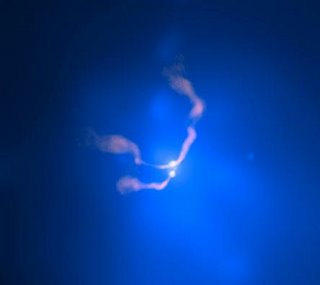Black holes revealed in death spin
 Scientists have found new evidence that a pair of voracious black holes in the galaxy cluster Abell 400 are orbiting one another, probably on a path towards an eventual merger. Learning more about such collisions could help astronomers seeking to detect the gravitational waves generated.
Scientists have found new evidence that a pair of voracious black holes in the galaxy cluster Abell 400 are orbiting one another, probably on a path towards an eventual merger. Learning more about such collisions could help astronomers seeking to detect the gravitational waves generated. Supermassive black holes are extremely dense, massive objects thought to have consumed millions or billions of stars from their surrounding environment. The Milky Way's own supermassive black hole, Sagittarius A*, is thought to contain the equivalent of about 4 million suns.
Radio waves from plasma-emitting jets associated with the two supermassive black holes in Abell 400 were first detected in 1984. Observations of the jets' bending and twisting behaviour indicated that the pair were interacting, but did not prove they were actually gravitationally bound.
Now, using the Chandra X-ray Observatory, scientists from the University of Bonn, Germany, the University of Virginia, US, and the US Naval Research Laboratory in Washington, DC, have shown that the jets streaming behind the two black holes bend in the same direction. This shows the black holes are traveling together through the galaxy cluster, and that suggests the two are orbiting each other.

0 Comments:
Post a Comment
<< Home